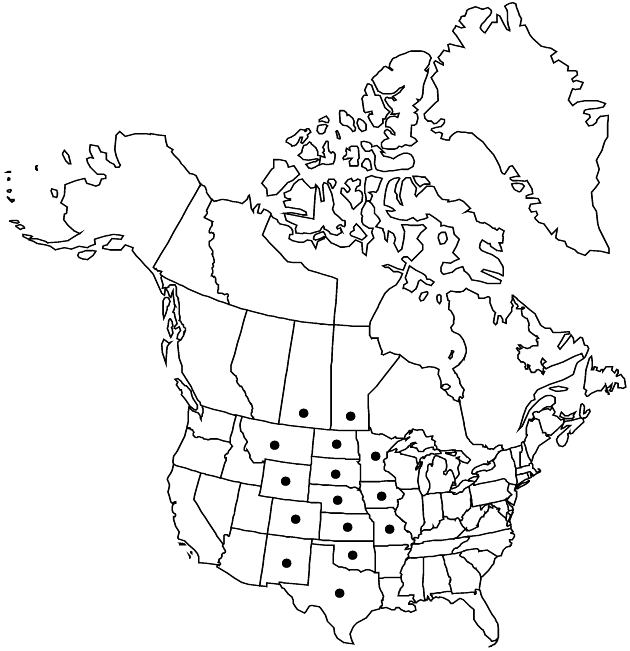Difference between revisions of "Echinacea angustifolia"
in A. P. de Candolle and A. L. P. P. de Candolle, Prodr. 5: 554. 1836.
FNA>Volume Importer |
imported>Volume Importer |
||
| (6 intermediate revisions by 2 users not shown) | |||
| Line 1: | Line 1: | ||
{{Treatment/ID | {{Treatment/ID | ||
|accepted_name=Echinacea angustifolia | |accepted_name=Echinacea angustifolia | ||
| − | |accepted_authority= | + | |accepted_authority=de Candolle |
|publications={{Treatment/Publication | |publications={{Treatment/Publication | ||
|title=in A. P. de Candolle and A. L. P. P. de Candolle, Prodr. | |title=in A. P. de Candolle and A. L. P. P. de Candolle, Prodr. | ||
| Line 8: | Line 8: | ||
}} | }} | ||
|common_names=Narrow-leaved purple coneflower;blacksamson echinacea | |common_names=Narrow-leaved purple coneflower;blacksamson echinacea | ||
| + | |special_status={{Treatment/ID/Special_status | ||
| + | |code=E | ||
| + | |label=Endemic | ||
| + | }} | ||
|basionyms= | |basionyms= | ||
|synonyms={{Treatment/ID/Synonym | |synonyms={{Treatment/ID/Synonym | ||
|name=Echinacea angustifolia var. strigosa | |name=Echinacea angustifolia var. strigosa | ||
|authority=McGregor | |authority=McGregor | ||
| + | |rank=variety | ||
}} | }} | ||
|hierarchy=Asteraceae;Asteraceae tribe Heliantheae;Asteraceae (tribe Heliantheae) subtribe Ecliptinae;Echinacea;Echinacea angustifolia | |hierarchy=Asteraceae;Asteraceae tribe Heliantheae;Asteraceae (tribe Heliantheae) subtribe Ecliptinae;Echinacea;Echinacea angustifolia | ||
| Line 27: | Line 32: | ||
|elevation=100–1600 m | |elevation=100–1600 m | ||
|distribution=Man.;Sask.;Colo.;Iowa;Kans.;Minn.;Mo.;Mont.;Nebr.;N.Mex.;N.Dak.;Okla.;S.Dak.;Tex.;Wyo. | |distribution=Man.;Sask.;Colo.;Iowa;Kans.;Minn.;Mo.;Mont.;Nebr.;N.Mex.;N.Dak.;Okla.;S.Dak.;Tex.;Wyo. | ||
| − | |discussion=<p>R. L. McGregor (1967, 1968) recognized Echinacea angustifolia var. strigosa as a complex of diploid and tetraploid populations ranging geographically from southeastern Kansas and central Oklahoma to north-central Texas. He noted that var. strigosa is distinguishable by its shorter stature, stems frequently branched, somewhat flexuous, distally strigose to strigose-hirsute that retain, in part, a green color upon drying. A hybrid origin for var. strigosa was suggested based on the morphologic intermediacy of natural populations compared to synthesized hybrids between typical E. angustifolia and E. atrorubens (McGregor 1968). Populations along the southern boundary of the range of var. strigosa are tetraploid. In their morphometric analyses, S. E. Binns et al. (2002) did not recognize var. strigosa; they found it indistinguishable from typical E. angustifolia.</p> | + | |discussion=<p>R. L. McGregor (1967, 1968) recognized <i>Echinacea angustifolia</i> var. strigosa as a complex of diploid and tetraploid populations ranging geographically from southeastern Kansas and central Oklahoma to north-central Texas. He noted that var. strigosa is distinguishable by its shorter stature, stems frequently branched, somewhat flexuous, distally strigose to strigose-hirsute that retain, in part, a green color upon drying. A hybrid origin for var. strigosa was suggested based on the morphologic intermediacy of natural populations compared to synthesized hybrids between typical <i>E. angustifolia</i> and <i>E. atrorubens</i> (McGregor 1968). Populations along the southern boundary of the range of var. strigosa are tetraploid. In their morphometric analyses, S. E. Binns et al. (2002) did not recognize var. strigosa; they found it indistinguishable from typical <i>E. angustifolia</i>.</p> |
|tables= | |tables= | ||
|references= | |references= | ||
| Line 36: | Line 41: | ||
-->{{#Taxon: | -->{{#Taxon: | ||
name=Echinacea angustifolia | name=Echinacea angustifolia | ||
| − | + | |authority=de Candolle | |
| − | |authority= | ||
|rank=species | |rank=species | ||
|parent rank=genus | |parent rank=genus | ||
| Line 50: | Line 54: | ||
|publication title=in A. P. de Candolle and A. L. P. P. de Candolle, Prodr. | |publication title=in A. P. de Candolle and A. L. P. P. de Candolle, Prodr. | ||
|publication year=1836 | |publication year=1836 | ||
| − | |special status= | + | |special status=Endemic |
| − | |source xml=https:// | + | |source xml=https://bitbucket.org/aafc-mbb/fna-data-curation/src/2e0870ddd59836b60bcf96646a41e87ea5a5943a/coarse_grained_fna_xml/V19-20-21/V21_206.xml |
|tribe=Asteraceae tribe Heliantheae | |tribe=Asteraceae tribe Heliantheae | ||
|subtribe=Asteraceae (tribe Heliantheae) subtribe Ecliptinae | |subtribe=Asteraceae (tribe Heliantheae) subtribe Ecliptinae | ||
Latest revision as of 21:10, 5 November 2020
Plants to 70 cm (roots usually fusiform, ± branched). Herbage moderately to densely hairy (induments relatively harsh, hairs spreading, ca. 1–2 mm). Stems mostly green to purplish. Basal leaves: petioles 2–12 cm; blades (1-), 3-, or (5-)nerved, elliptic to lanceolate, 7–30 × 0.5–2.5(–4) cm, bases cuneate to attenuate, margins entire (usually ciliate). Peduncles 10–30 cm. Phyllaries lanceolate to ovate, 6–12 × 1–2.5 mm. Receptacles: paleae 9–14 mm, tips purple, straight, sharp-pointed. Ray corollas pink to purplish, laminae reflexed, 15–40 × 5–8 mm, sparsely hairy abaxially. Discs conic to hemispheric, 15–30 × 20–35 mm. Disc corollas 5–7+ mm, lobes usually purple. Cypselae often bicolored, tan proximally, dark brown banded distally, 4–5 mm, faces ± smooth, usually glabrous; pappi to ca. 1 mm (major teeth 0–4). 2n = 22, 44.
Phenology: Flowering late spring–mid summer.
Habitat: dry prairies, barrens, rocky to sandy-clay soils
Elevation: 100–1600 m
Distribution

Man., Sask., Colo., Iowa, Kans., Minn., Mo., Mont., Nebr., N.Mex., N.Dak., Okla., S.Dak., Tex., Wyo.
Discussion
R. L. McGregor (1967, 1968) recognized Echinacea angustifolia var. strigosa as a complex of diploid and tetraploid populations ranging geographically from southeastern Kansas and central Oklahoma to north-central Texas. He noted that var. strigosa is distinguishable by its shorter stature, stems frequently branched, somewhat flexuous, distally strigose to strigose-hirsute that retain, in part, a green color upon drying. A hybrid origin for var. strigosa was suggested based on the morphologic intermediacy of natural populations compared to synthesized hybrids between typical E. angustifolia and E. atrorubens (McGregor 1968). Populations along the southern boundary of the range of var. strigosa are tetraploid. In their morphometric analyses, S. E. Binns et al. (2002) did not recognize var. strigosa; they found it indistinguishable from typical E. angustifolia.
Selected References
None.